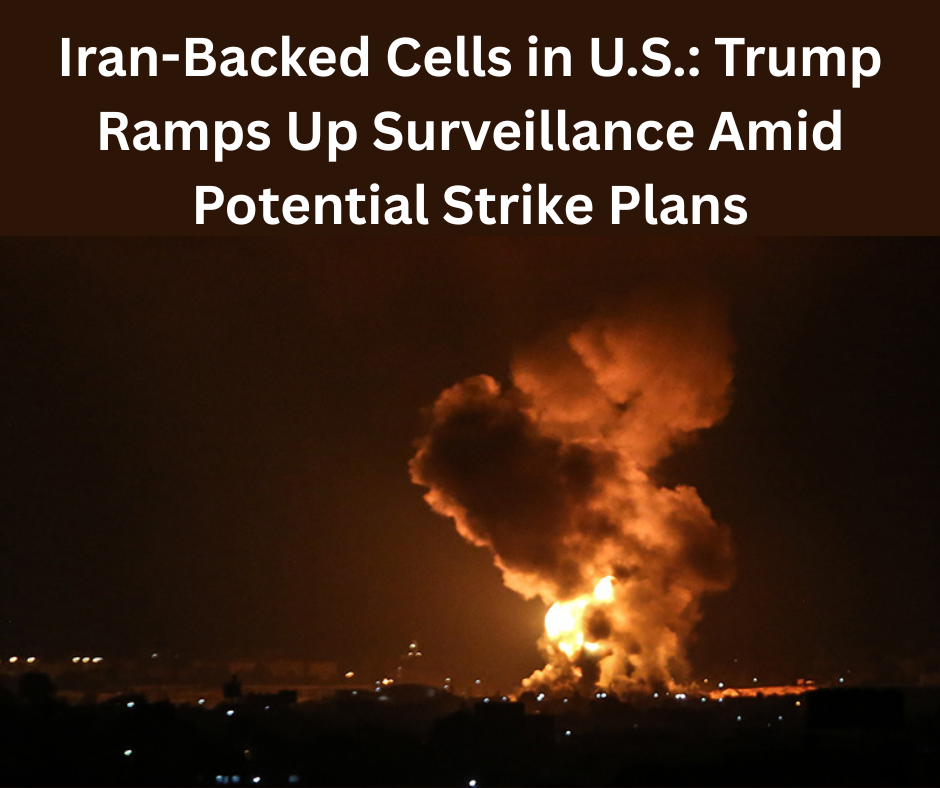Iran-Backed Cells in U.S.
Heightened Surveillance on Iran-Backed Cells in U.S. Amid Rising Global Tensions
In light of increasing geopolitical tensions, U.S. federal agencies have intensified their efforts to monitor Iran-backed cells in the U.S., signaling growing concern about potential threats tied to ongoing conflicts in the Middle East.
Trump Administration Responds to Potential Threats
Former President Donald Trump’s administration has reportedly ramped up intelligence operations targeting suspected Iran-linked operatives within U.S. borders. This development comes as the administration weighs possible military strikes on Iran’s nuclear infrastructure. Sources indicate that FBI Director Kash Patel has directed increased monitoring of domestic networks possibly connected to Hezbollah—an Iran-backed organization labeled as a terrorist group by the U.S. government.
Although neither the FBI nor the White House has issued formal comments, insiders confirm the urgency of the surveillance measures in response to the evolving security situation.
Why Iran-Backed Cells in the U.S. Are Raising Alarms
Concerns about Iran-backed cells in the U.S. are not new. The assassination of General Qassem Soleimani in 2020 marked a critical turning point. Since then, intelligence communities have feared retaliatory attacks orchestrated or inspired by Iranian actors.
The Justice Department has previously revealed attempts by Iran’s Islamic Revolutionary Guard Corps (IRGC) to target U.S. nationals. In one recent case, two U.S.-based individuals were charged with assisting an IRGC agent in surveilling critics of the Iranian regime, including an alleged plot against former President Trump.
These developments underscore the complex and persistent threat landscape tied to Iran’s global influence operations.
Hezbollah Activity Under the Spotlight
Law enforcement officials are particularly focused on Hezbollah’s network in the United States. Although no credible attacks have been confirmed recently, agencies are acting out of an abundance of caution. Analysts warn that Hezbollah operatives could be “activated” should diplomatic or military tensions escalate between the U.S. and Iran.
Investigations now include reviewing known associations, communication patterns, and potential financial flows supporting terrorist-linked organizations. The FBI, Department of Homeland Security, and other entities are pooling resources to track these activities closely.
Risk of Lone Wolf Attacks Remains a Priority
Among the key concerns are so-called “lone wolf” attacks—isolated incidents by individuals radicalized or influenced by foreign agendas, often without direct communication with terrorist networks. These threats are notoriously difficult to predict and prevent.
Federal law enforcement remains on high alert, monitoring online chatter and maintaining close watch on suspects flagged in previous counterterrorism probes related to Iran-backed cells in the U.S..
Past Plots and Persistent Risks
Several prominent figures, including former National Security Advisor John Bolton and journalist Masih Alinejad, have previously been targeted in plots tied to Iranian interests. While security measures have prevented harm so far, these attempts highlight the very real risks to individuals seen as adversaries by Tehran.
In addition, threats have expanded into cyberspace. Iran-affiliated hackers have been implicated in breaching Iran-Backed Cells in U.S. political campaigns, raising alarms about hybrid warfare strategies that blend physical and cyber-based threats.
Southern Border Security Raises More Concerns
National security experts like Jonathan Gilliam have voiced concerns about how porous border controls may have allowed sleeper cells to enter the country undetected. He warns that Iran-Backed Cells in U.S. or its proxies could exploit vulnerabilities to plant operatives who may lie dormant until activated for strategic missions.
Former border officials like Tom Homan have echoed similar sentiments, citing over two million “gotaways” at the border and emphasizing the need for rigorous vetting and surveillance mechanisms to detect potential Iran-backed cells in the U.S..
No Imminent Threats, But Precautions Intensify
Officials have reiterated that no credible or specific threats have emerged recently. However, security postures around key sites in Washington, including the White House, Pentagon, and Israeli embassy, have been reinforced. These actions are part of standard protocol during international crises but reflect broader vigilance tied to possible escalation.
James Carafano, a senior fellow at the Heritage Foundation, emphasized the challenge in identifying sleeper cells: “If they’re effective, we won’t know about them until they strike.”
This uncertainty drives the need for continued surveillance, intelligence sharing, and public awareness—especially as the U.S. contemplates new actions against Iran’s nuclear facilities.
Financial Networks Supporting Iran-Backed Groups Also Scrutinized
Beyond physical threats, U.S. authorities are investigating how terrorist organizations, sometimes with Iranian connections, receive funding from sources within the country. Following the October 7, 2023, Hamas attack on Israel, this line of inquiry has intensified.
The FBI has made it a priority to dismantle any domestic financial pipelines that may aid foreign terrorist groups. While fundraising activities are difficult to trace, any proven connection to Hezbollah or Hamas is swiftly dealt with under anti-terrorism laws.
Conclusion: Vigilance Over Iran-Backed Cells in the U.S. Remains Critical
As U.S.-Iran tensions simmer, intelligence agencies continue their comprehensive monitoring of Iran-backed cells in the U.S. Although no immediate or credible attacks have been identified, the mere possibility of such threats necessitates a strong, proactive national security strategy.
With past plots, ongoing investigations, and geopolitical instability, the focus on preventing violence from domestic or foreign actors linked to Iran-Backed Cells in U.S.is more vital than ever. Americans are urged to remain alert while trusting federal agencies to detect and respond to any emerging threats in real time.
Read more: Hot Air Balloon Crash In Brazil
